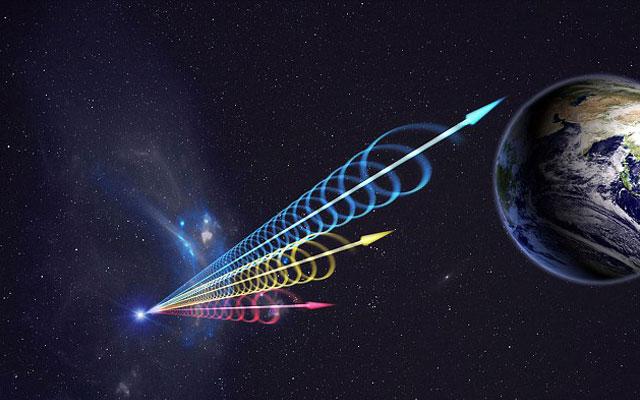
十亿太阳事件
Billion Sun–Bright Events Leave Radio Wave Clues
十亿太阳事件
“Fast radio bursts” detected here on Earth last only a thousandth of a second, but are the result of a faraway source briefly shining a billion or more times brighter than our sun.
在地球上测得的“快速射电爆”仅维持了短短的数千分之一秒,然而信号却是源于远离地球、其亮度为太阳数十亿倍且转迅即逝的天文现象。
撰文/播音 李·比林斯(Lee Billings)
翻译 Meatle
审校 乔虹
Radio waves are invisible to our eyes. But if you could see them, the sky would dance with random tiny flashes. Thousands of what are called “fast radio bursts” are estimated to occur every day. And though each pinprick flash lasts only a thousandth of a second, they represent a faraway source briefly shining a billion or more times brighter than our sun.
我们的肉眼并不能看到电磁波。如果电磁波能够被我们看到的话,天空将会充斥着无规律的微小闪光。据估计,每天均发生着数以千次被称为“快速射电爆”的现象。尽管这些微小的闪光仅仅持续数千分之一秒,它们都是遥远宇宙中亮度数十亿倍于太阳的短暂天文现象的产物。
Fast radio bursts have been known for nearly a decade, but scientists have struggled to determine exactly where they come from. And they’d like to know. Because finding their origins would help astronomers use the bursts as probes to map the history and structure of the universe in unprecedented detail.
快速射电爆已被发现将近10年,但是科学家们仍在努力地找出这些电磁波的确切来源。而且他们很希望能得到答案。因为找出这些电磁波的出处,天文学家就能使用这些信号在空前详尽的尺度上观测宇宙历史和结构。
Now researchers have found the source of one particular burst. They used radio telescopes in Australia and the giant Subaru optical telescope in Hawaii to trace a burst observed last April. And they determined it came from an old elliptical galaxy full of exhausted, dying suns some six billion light-years away. The findings are in the journal Nature. [Link to come]
现在,研究人员发现了某个特定射电爆的来源。去年四月,他们使用了澳大利亚的射电望远镜与位于夏威夷的巨型斯巴鲁(Subaru)光学望远镜追踪了一次射电爆。他们确定了这次射电爆来源于距离地球六十亿光年的一个满是垂死的太阳的古老的椭圆星系。这项发现发表在《自然》期刊上。
Identifying the source galaxy provides crucial clues. For one thing, such a galaxy is short on some of the objects expected to cause bursts, such as supernovae or rapidly spinning and flaring pulsars, suggesting this burst came from something else. And, although the burst in question lasted only milliseconds, astronomers were able to witness its faint, fading radio afterglow for about six days. That’s the sort of afterglow expected from a colliding pair of ancient neutron stars, which would be a relatively common occurrence among an elliptical galaxy’s geriatric suns.
射电爆来源星系的确认提供了重要的线索。一方面,这样的星系缺乏被认为能够爆发的天体,例如超新星或者是快速旋转和闪光的脉冲星,这暗示着这些射电爆来源于其他天文现象。同时,尽管这存疑的星爆仅仅持续了数微秒,天文学家仍能够在其后的六天中观测到其黯哑的余晖。这种余晖被认为是来自两颗古老中子星的相撞,这种现象在椭圆星系的年老的太阳中较为常见。
Even though this particular burst has probably been explained, many mysteries remain—not all bursts seem to come from the same cosmic source. Fortunately, most possible burst sources could be distinguished by the gravitational waves they emit, like those recently seen by the Laser Interferometer Gravitational-Wave Observatory, or LIGO. That means researchers may soon be searching the skies for both radio and gravitational waves for these bursts, to help draw an ever more detailed map of the cosmos.
尽管这一次特定的射电爆可能获得了解释,但对于快速射电爆仍存有很多疑问,比如并不是所有的射电爆均源于相似的天文条件。幸运的是,大多数可能的射电爆来源均可以根据它们发出的引力波进行识别,就像最近那些被激光干涉引力波天文台(LIGO, Laser Interferometer Gravitational-Wave Observatory)观测到的天文现象一样。这意味着,不久的将来,研究人员将会用引力波和电磁波来寻找射电爆的来源,以绘制出详尽程度前所未有的星图。
未经书面许可任何人不得复制或镜像
京ICP备11000850号-1
 京公网安备11010502039775号
京公网安备11010502039775号 信息网络传播视听节目许可证0111611号
国家科技基础条件平台

















